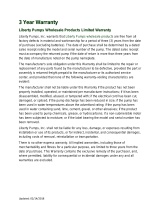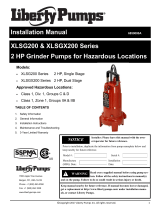
©Copyright 2013 Liberty Pumps Inc. All rights reserved - 5 -
10. For switchless models: Switchless models may be operated by directly plugging into an approved electrical
outlet. To prevent excessive seal wear and overheating, pumps should not be run dry for extended periods of
time. A minimum 4-1/2” water level is recommended. If manual models are to be used with an optional control
device, follow the instructions provided with that control and make power connections per those instructions. Set
the turn-off level at 4-1/2” or greater. Do not remove float rods from VMF models for manual use, as switch
damage will result.
4. Trouble-Shooting
Always disconnect the pump from power source before handling. This guide is designed
to help identify reasons for potential operating problems. It is not a service guide. Dismantling of pump voids
warranty. Servicing of pump other than simple cleaning of pump inlet or impeller should be referred to the factory
or its authorized service centers.
PUMP DOES NOT RUN OR HUM.
1. Line circuit breaker may be off, tripped or loose. Have certified electrician check fuse or breaker.
2. Water level in pit may be too low to activate switch. Add more water to pit.
3. Plug on power cord may not be making contact in receptacle. Check security and connection.
4. If the pump is using the series (piggyback) cord plug, the plugs may not be connected tightly together.
5. Float may be obstructed. Make sure float is free and not interfering with the pit wall or other obstruction.
6. If all symptoms check OK, the motor winding may be open. Consult factory.
PUMP RUNS OR HUMS BUT DOES NOT DELIVER WATER.
1. Check valve may be installed backwards or is defective. Check to make sure it is installed properly and
flapper in valve is free to move.
2. Discharge line may be blocked or frozen. Check to see if line passes through cold areas or is blocked.
3. Pump may be air-locked. Make sure that an anti-airlock hole was drilled in discharge pipe. Submersible
models are factory equipped with a bleed hole already in base of pump. Ensure that this hole is not plugged.
4. Vertical lift may be beyond pumps capability. See chart below for your pump’s maximum lift capability.
NOTE: At the pump’s maximum lift there will be no flow.
5. Check to see if inlet screen of pump is plugged or the impeller is jammed. Remove the pump screen and
clean inlet and impeller as needed.
6. Pump Impeller may be jammed. Check for foreign material such as construction debris, stones, etc. that might
be preventing the impeller from rotating. Reminder: Make sure pump is disconnected from power source
before checking inlet and impeller area.
PUMP RUNS AND REMOVES WATER BUT DOES NOT SHUT OFF.
1. Float is stuck in the “on” position. Check to make sure the float is free to move up and down without
obstruction.
2. Switch may be defective. Consult factory.
PUMP RUNS BUT DELIVERS VERY LITTLE WATER.
1. Vertical lift is approaching the pump’s maximum lift capability. Refer to the above maximum lift chart above.
2. Pump’s inlet is partially blocked. Check to make sure the inlet is clear of debris.
3. Discharge line is partially blocked. Check line for blockage.
4. Check valve is not opening all the way. Check for defective, reversed, or blocked check valve.
CIRCUIT BREAKER TRIPS OR FUSE BLOWS WHEN PUMP STARTS.
1. Fuse or breaker size is too small.
2. Other major appliances are on the same circuit. Pump should be on its own circuit.
NOTE: The manufacturer assumes no responsibility for damage or injury due to disassembly in the field.
MODEL MAX. LIFT
230-Series 21’
240-Series 20’
450-Series 34’












